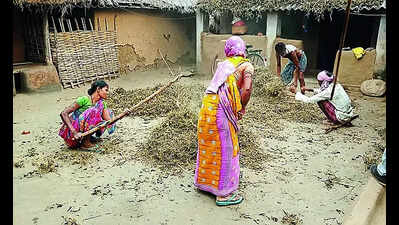Second Crop Farming: Study reveals increase in income through second crop farming | Bhubaneswar News


Bhubaneswar: A study conducted by Atmashakti Trust, a non-profit outfit, on second crop farming found that the farming has resulted in increasing the income of farmers and reducing their migration activities in the state. The study was conducted by Odisha Shramajeebee Manch and Mahila Shramajeebee Manch through Atmashakti Trust in March this year among 2,008 farmers in Gajapati, Boudh, Nabarangpur and Deogarh districts.
The farmers were provided with seeds of green gram, black gram, horse gram and chickpea during 2023-24 under the Rice Fallow Management Programme of the state govt for taking up the second crop farming following kharif season.The study found that farmers grew Rabi crops this year yielding an average of 154 kg from 0.9 acres of land resulting in an income of Rs 15,000 per farmer from green gram and black gram seeds.
The study also found that the second crop farming has improved the soil health of the land. The cultivation of leguminous crops like green gram, black gram, horse gram and chickpea has helped in fixing the nitrogen in the soil, which has improved its fertility.
“After the kharif season, the land remained fallow forcing the farmers to go in distress. The Rice Fallow Management Programme of the state govt aimed to improve the condition of the farmers of the state,” said Ruchi Kashyap of Atmashakti Trust.
She said awareness is required among farmers where the role of Atmashakti Trust came into play. “The income from the second crop is more than 50 days of MGNREGA wages and more than double the incentive given under PM Kishan Yojana,” she said.
The study has recommended that the govt should expand the programme to other districts of the state so that more farmers can benefit from it.
“I received moong seeds for the second crop. I sowed the seeds on 1.5 acres of land and got a yield of one quintal and 60 kg. Out of that I stored 10 kg for next year seed and kept 40 kg for my family consumption and rest I sold in the market for Rs 11,000,” said Sulochana Sethi, a farmer of Boudh.
We also published the following articles recently
Discover the latest agricultural updates in Maharashtra with a significant increase in kharif sowing due to good rainfall. Pune division leads the way with impressive soybean sowing. Stay informed about the challenges farmers face with disease control measures.
Discover how floods in Assam benefit farmers in Morigaon and Kamrup districts by enriching soil for Boro rice cultivation. Villagers have adapted to coexist with annual inundation, strategically building homes on higher ground. Learn about the challenges posed by reduced rainfall on the natural fertilization process.
Learn about the recent grievances voiced by Cotigao villagers towards the local panchayat committee regarding monsoon works and project delays. Find out the details of the resolution passed against the forest department’s tree pruning practices in the village.















